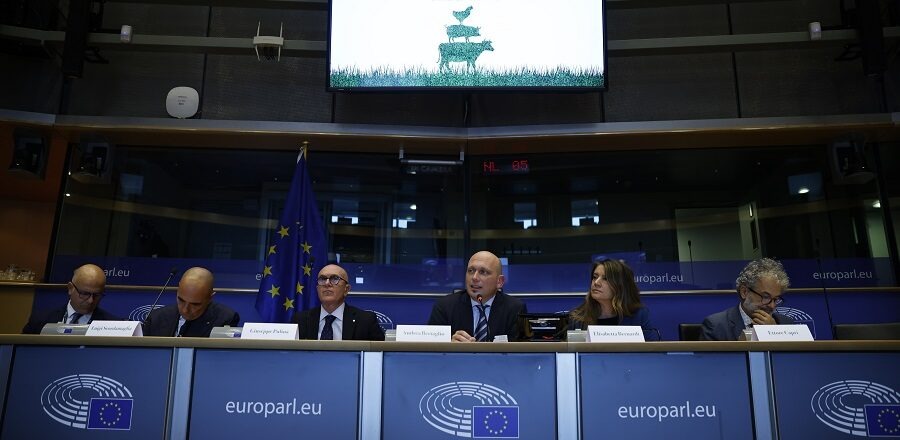
Methane emissions from herbivores have always existed
Greenhouse gas emissions by large herbivores are not a phenomenon these days. Professor Pulina clarifies this issue, and reveals a noteworthy aspect: if we eliminated all farms and animals were free to graze in nature, their contribution to greenhouse gases would be exactly the same.
It seems paradoxical that in a world where thousands of tons of greenhouse gases from cars, planes, ships, power plants, factories, landfills, rice fields, etc. are discharged into the atmosphere every day, we want to blame the flatulence of farmed herbivorous animals for the greenhouse effect and climate change, a completely natural phenomenon with very ancient origins.
Just think of the large sauropods that lived for a very long time, over 120 million years in the geological Mesozoic era (Jurassic and Cretaceous from 190 to 65 million years ago): they were the most impressive terrestrial animals ever appeared on earth, just remembered for their gigantism. They could in fact reach about 100 tons of weight (Argentinosaurus), a length up to 40 meters, and about 20 meters of height. They were herbivores like our ruminants today, generating methane in quantities that would contribute to global warming that occurred in that era.
The #grazing #fauna in #Europe and #America, before the agricultural-zootechnical processes, recorded #emissions in line with those of #wild and #DomesticAnimals today in these areas. Click To TweetIn the book (“Animal breeding and environmental sustainability: the technologies” (“Allevamento animale e sostenibilità ambientale: le tecnologie”) by B. Stefanon, M. Mele and G. Pulina, ed. Franco Angeli), studies show how the presence of methane originating from the digestive fermentations of herbivores has been a constant element in the history of Earth, and even the fauna grazing in Europe and America, before the establishment of agricultural-zootechnical processes, recorded emissions in line with those currently deriving from wild and domestic animals present in these areas.
Regarding the digestive process, in large sauropods, there was a microbiome capable of fermenting fiber and making the essential nutrients available for the animal’s life. The oral process consisted of burning and ingesting huge quantities of biomass, generating important quantities of methane of the same size as the current total, 6 to 12 times higher than the global pre-gastric methanogenesis estimated by FAO for today’s domestic ruminants. If paradoxically, all domestic animals were eliminated and the lands occupied by them were returned to the natural presence of wild herbivores, the enteric emission condition would not change substantially.
If we would eliminate all the #farms and the #animals free to graze in #nature, their contribution to the #GreenhouseGases would be exactly the same. Click To TweetSo, even if we eliminated all farms, and animals were free to graze in nature, their contribution to greenhouse gases would be exactly the same. Indeed it could be even worse for the climate, since in farms it is possible to modulate enteric fermentation thanks to a balanced feeding of animals, while in nature they would be free to eat what they find, with uncontrolled fermentation and consequent much higher gas emissions.
Another confirmation comes from other important studies (Kelliher FM, Clark H., 2012. Methane emission from bison – An historic herd estimate for the North American Great Plains. Agricultural and Forestry Meteorology, 150: 474-477) in which the authors calculated the enteric methane production of the American bison (Bison bison), a species which was later drastically reduced by man-made hunting.
#GlobalWarming is the result of the accumulation of #GHGs deriving from other #HumanActivities and cannot be mainly attributed to #livestock. Click To TweetThe researchers estimated the enteric productions of this population in 2.1 million tons per year, comparing them with today’s emissions of cattle raised in the same area, obtaining a value of 2.5 million tons of methane emitted and detecting that the replacement of the pre-Columbian grazing macrofauna with modern farms led to only 14% of the increase in emissions.
Also, subsequent work has obtained similar results (Hristov AN, 2012. Historic, pre-European settlement, and present-day contribution of wild ruminants to enteric methane emission in the United States. Journal of Animal Science, 90: 1371-1375) by widening the study area to the entire USA and to the overall population of wild herbivores present in the pre-Columbian era: comparing the emissions with the current breeding of zootechnical animals in the USA and today’s contribution of wild animals to enteric emissions of methane, it can surprisingly be noted that in pre-Columbian times the methane emitted by ruminants was equal to 86% of that currently poured into the atmosphere by domestic cattle, sheep, and goats.
In countries with state-of-the-art #AnimalHusbandry, the contribution of #livestock to #GHGS #emissions ranges from 2 to 8%; in Italy only 3%. Click To TweetTherefore, the 80 million wild bison that lived on the Great Plains, numbers close to the 90 million beef cattle now bred in the United States, 75 of which are bred in the prairies, and the 150 megafauna species in the Americas that existed at the end of the Pleistocene, including mammoths, big cats, giant sloths and much larger bears than today, produced methane emissions close to those emitted today by farm cattle. It confirms that global warming today is the result of the accumulation of greenhouse gases deriving from other human activities and it cannot be mainly attributed to the presence of livestock herbivores.
For this reason, if it is true that the enteric emissions of ruminants today contribute for a part, this, however, is not so significant as to justify the fury against the livestock sector, which is indeed vital for agriculture, for the landscape and biodiversity. Especially in countries with avant-garde animal husbandry, the contribution of farms is only 2 to 8%, with only 3% in Italy. There are other really guilty activities we will have to focus on, such as transport and the energy sector. So, changes will have to concern mainly the conversion from fossil fuels towards the use of 100% renewable energy.
A legitimate concern on #GHGs #emissions is shifting towards an unfounded fear of #meat. But #AnimalHusbandry is part of the #solution, not the problem. Click To TweetFor example, only gas losses due to oil extraction emit thirteen million tons of methane into the atmosphere every year, corresponding to double that released every year by cows raised all over the world. As the American writer Paul John Scott also explains: “The campaign underway to shame the world into giving up animal food in the name of climate change is a pure vegetarian projection, shifting a worthwhile fear of greenhouse gases onto an unfounded fear of meat. Livestock is part of the solution, not the problem.”





